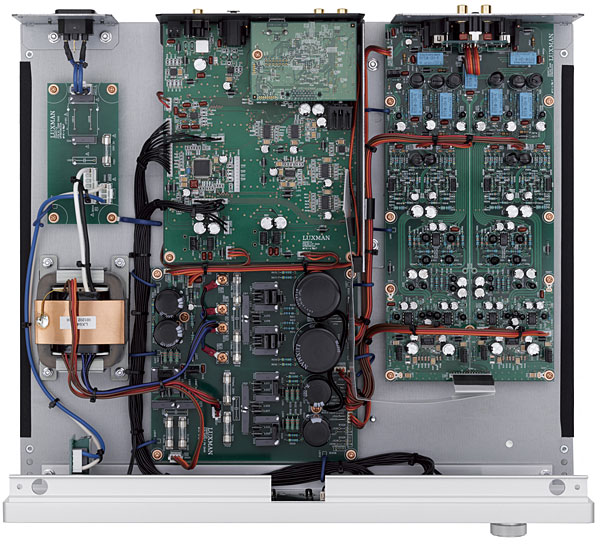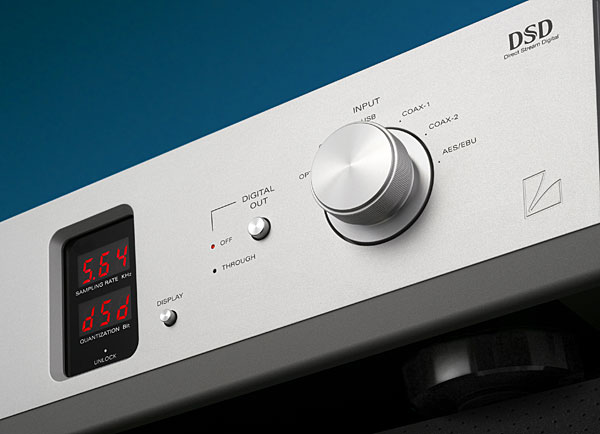| Columns Retired Columns & Blogs |
Hi
Great review as always
just one question, you say xlr has (pin2+) but manuel says normal(pin2 -)
which one is correct?
Thank you
sincerely
Mahesh kc

Purely acoustic music sounded just right through the Luxman—eg, Tony Rice's arrangement of the folk melody "Shady Grove," from his and Peter Rowan's Quartet (ripped from CD, Rounder 11661-0579-2). The lead acoustic guitar came across with all due color and texture, along with Rice's typically supple, limber note attacks. Even more impressive through the Luxman was double-bassist Bryn Davies's remarkable solo, which seemed to push the limits of color and texture ever further, and to add to them a spectacular sense of scale and sheer heft. The very long (but not necessarily lunar) note floated by cellist Pieter Wispelwey toward the end of the sixth of Tchaikovsky's Variations on a Rococo Theme, with Daniel Sepec and the Deutsche Kammerphilharmonie Bremen (ripped from CD layer of SACD/CD, Channel Classics CCS SA 16501), was an orgy of texture; even more so was Wispelwey's sound in Bruch's Kol Nidrei, from the same disc, providing the audio-playback ideal of an instrument so well reproduced that it becomes all but visible and tangible between the loudspeakers. And it's impossible to declare which sounded more stunningly real and present: the solo with which alto saxophonist Cannonball Adderley follows Bill Evans's own piano solo in "Goodbye," from Adderley's Know What I Mean? (AIFF ripped from CD, JVC XRCD VICJ-60243), or Percy Heath's bowed double bass at this track's beginning and end. During the Luxman DA-06's time in my system, these selections and several others cemented its reputation as a tone beast, which is rare indeed.
The Luxman's spatial performance was more than adequate to satisfy my limited need for same, and I suspect that stereo enthusiasts will find much to like here, with good if somewhat puffy image specificity and really good scale. The latter quality very much enhanced the effectiveness of the award-winning recording, by Lorin Maazel and the New York Philharmonic, of John Adams's On the Transmigration of Souls (CD, Nonesuch 79816-2), in which orchestra, two choruses, percussionists, solo trumpet, and prerecorded voices occupy, in turn, various spaces on the stage and build to an emotional climax. Nice to note the existence of digital playback that can make me cry.
And with DSD?
It is music's job to exist and to be enjoyed and understood; it is not music's job to show off anyone's hi-fi system. But if it were, then I would say that the DSD recording, by Iván Fischer and the Budapest Festival Orchestra, of Mahler's Symphony 2 (SACD/CD, Channel Classics CCS SA 23506) put the Luxman DA-06 in an especially good light. Working together, that recording and this bit of hardware allowed the big DeVore Fidelity Orangutan O/96 speakers to step further out of the way, spatially, than usual, while not robbing the music of its substance. The Luxman also captured the power of the bass drum in the third movement, and distinguished the instrument's timbral character from that of the timpani. And its retrieval of musical detail—for example, the glissando in the violins starting at 4:20 in the first movement—was exemplary.
On the negative side, string tone was slightly smoothed over and bereft of texture (though not as plasticky as the sound I hear from some expensive digital gear), and overall, this recording was among those that, no matter how far to the right I turned the volume knob, I couldn't seem to get loud enough: It did not satisfy. Bear in mind that, as a newcomer to the world of streaming DSD, I don't know if the fault was in the recording, the DAC, or in DSD itself.
The DA-06 did a fine, engaging job with a DSD-encoded DSF file of "Lonesome Tears," from Beck's Sea Change (Geffen B0004372-01, footnote 2). Bass was firm and deep, and the voices, while fraught with the excess sibilance of very close miking, were no less tolerable than from the LP. The song had all the drama and import and impact that it should. The LP was a little less bright—probably just a function of the phono cartridge used for the needle drop—and had a slight advantage in terms of texture. That said, there was no shortage of texture in the sound of Ben Webster's saxophone, in a DSF file of "When Your Lover Is Gone," from Ben Webster Meets Oscar Peterson (Verve MG VS 6114)—likewise the lovely, rich sound of Ray Brown's double bass. The Luxman also did a supremely analog-like job with "St. Thomas," from Sonny Rollins's Saxophone Colossus (Prestige 7079). The tone of his tenor was indeed colossal, and Max Roach's calypso percussion had surprisingly good impact and touch: an 8 on a scale of 1–10, with 10 being the mono Prestige LP played on my Garrard-EMT-EMT record player.

In a final and admittedly fussy comparison, I spent a considerable amount of time going back and forth between PCM (24/192) and DSD files of "Take Five," from the Dave Brubeck Quartet's Time Out. In some ways, the PCM file actually sounded a bit better—especially in terms of bass power, where the PCM file was more enjoyable than the slightly less weighty DSD file. But in musical terms, the DSD was obviously superior. Joe Morello's drumming—which is a bit stiffer than the ideal to begin with—sounded mechanical via PCM, whereas the DSD restored the naturalness and micro-randomness that said: This is a human playing, not a machine. It seems that today, as on that day 15 years ago when I experienced my first demonstration of SACD, DSD's prowess at communicating the subtleties of musical flow is beyond doubt.
Conclusions
How to put the Luxman DA-06—and, especially, its DSD capabilities—in perspective? It's a bit like my EMT OFD 65 pickup head: a classic, low-compliance phono transducer that's designed to play 78rpm records and nothing else. I trot it out only once or twice a month, yet it's a thoroughly indispensable product, something I would not wish to be without. Yes, I've got five or six CDs' worth of Louis Armstrong's music from before the 1930s—but when I want to hear what "I Can't Give You Anything But Love" or "You're Driving Me Crazy" really sound like, the 78 is the only choice. Similarly, for the listener who possesses a good number of DSD files—that and, perhaps, the faith that it may someday be possible and legal to rip to his hard drive the SACDs he thinks he owns—then something like the DA-06 would seem a borderline necessity.
Still, for everyone else, the Luxman DA-06 is a damn fine-sounding D/A converter with virtually all music: insightful, explicit, substantial, colorful, and as consistently analog-like a digital product as I have heard. That it is also attractive, easy to use, and made by a corporation that will turn 90 next year tips the balance toward an enthusiastic recommendation.

Hi
Great review as always
just one question, you say xlr has (pin2+) but manuel says normal(pin2 -)
which one is correct?
Thank you
sincerely
Mahesh kc

Great review as always
Thank you.
just one question, you say xlr has (pin2+) but manuel says normal(pin2-) which one is correct?
My measurements clearly indicated that the XLR jacks on our sample were wired with pin 2 hot, the DAC being non-inverting when connected to the Audio Precision, which has pin 2 hot.
John Atkinson
Editor, Stereophile